A lower back massage focuses on a range of muscles including the latissimus dorsi, quadratus lumborum and the erector spinae, located around the lower half of the spine. Pain in the lower back can be caused by many different reasons. The main reason for lower back pain includes muscle tightness. A lower back massage helps warm up muscles and increase blood and lymphatic circulation, encouraging more healthy nutrients to be passed around the body and more toxins to be removed. A lower back massage uses a variety of different techniques to help treat a range of injuries. Our massage therapists at Physio.co.uk use lower back massage to help reduce tension, pain and tightness of the muscles.
What techniques are used in a lower back massage?
There are a range of different techniques used during a lower back massage. The techniques used during a lower back massage include:
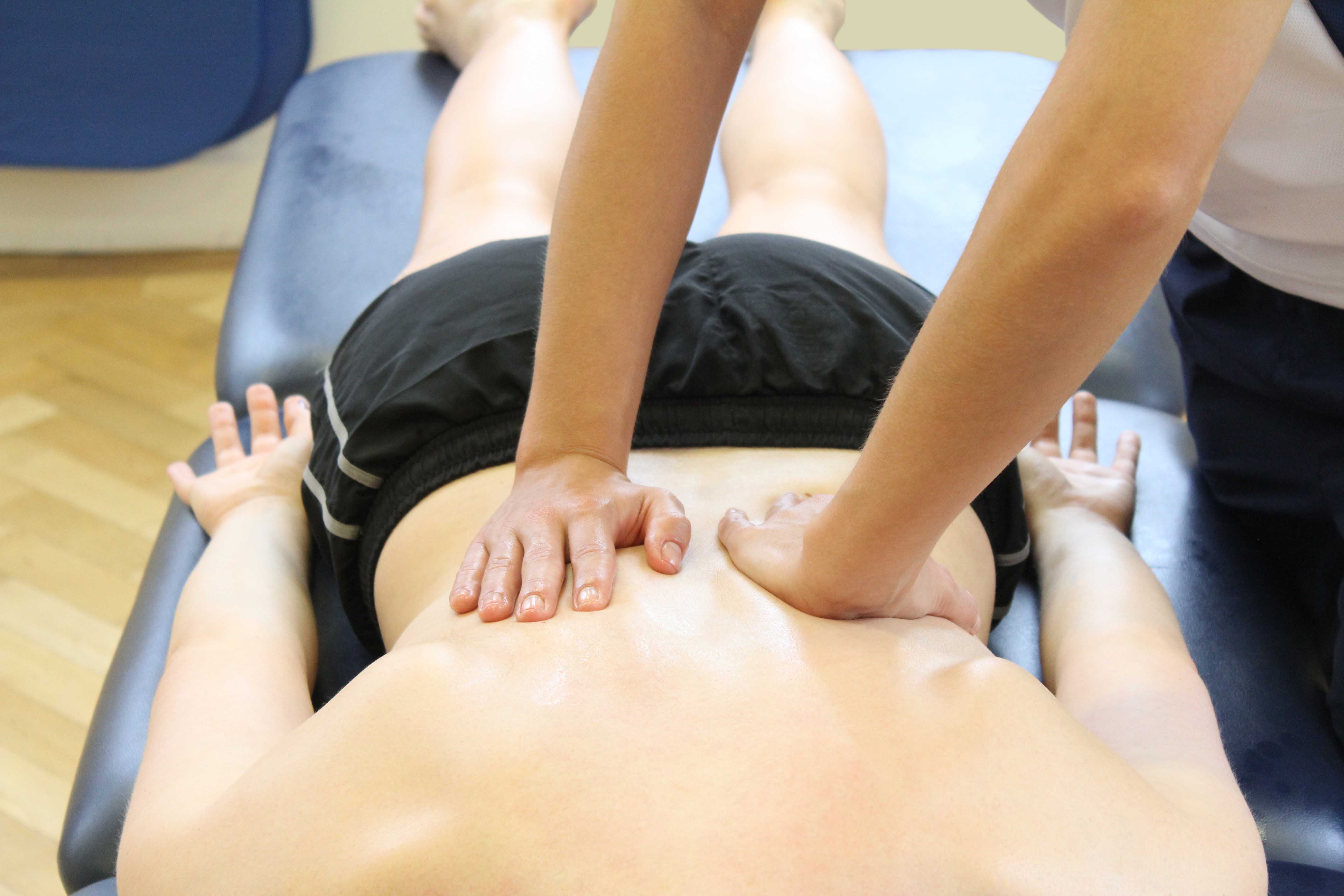 Above: Therapist applying compression massage to lower back
Above: Therapist applying compression massage to lower back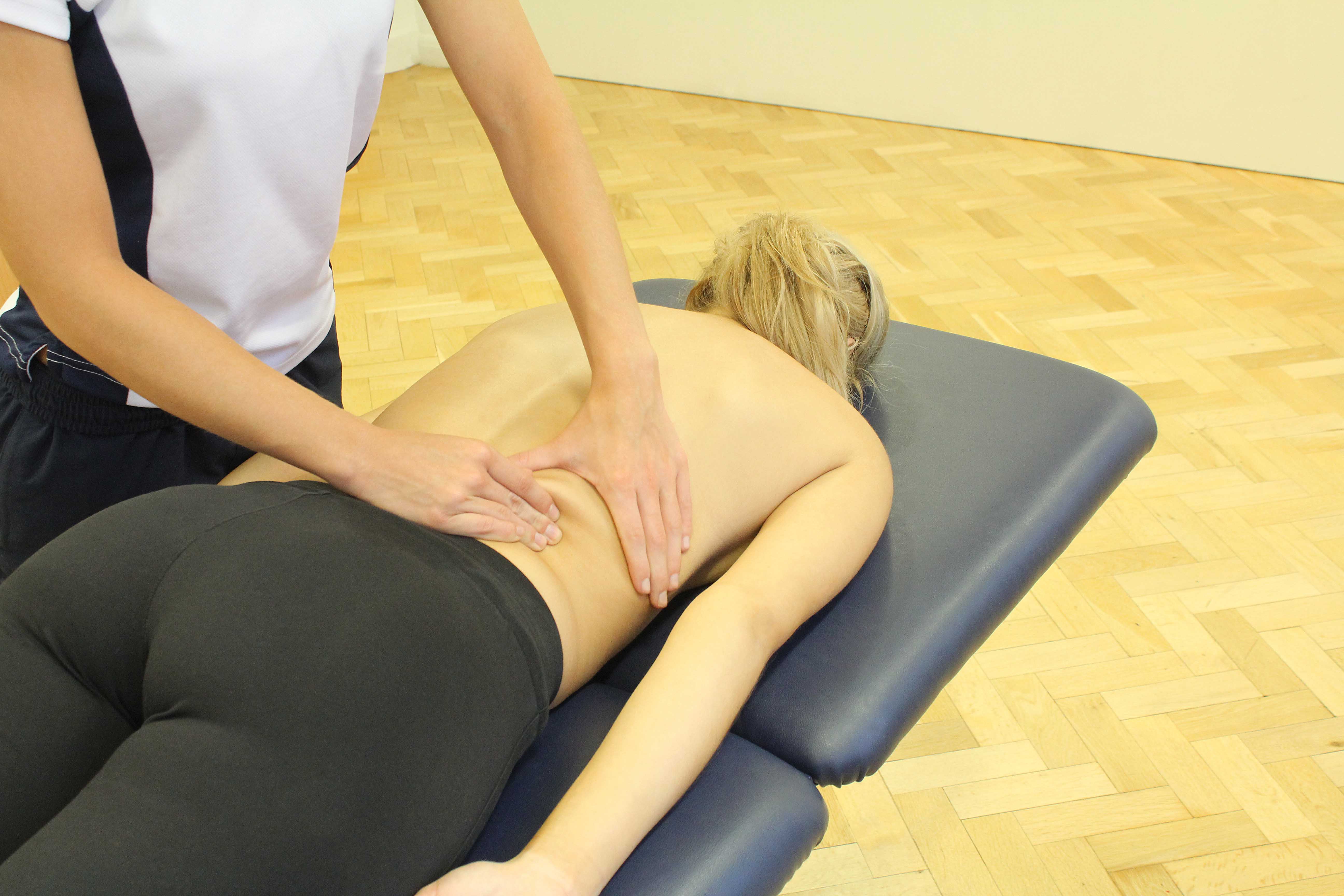 Above: Kneading massage technique applied to lower latissimus dorsi muscle
Above: Kneading massage technique applied to lower latissimus dorsi muscleAcupressure is a technique commonly used during a lower back massage. Pressure is placed on specific points found within soft tissues. Acupressure is performed using the fingers and thumbs and aids in improving the circulation of the blood to the lower back. When pressure is placed on muscular knots, blood flow to this area is restricted. When blood flow is restricted, this is called an ischemic reaction. Muscular knots are broken down and softened as the pressure is applied. When pressure is released an increase in blood flow is encouraged as the body detects there is some damage. An increase in blood flow to the area helps bring more oxygen and nutrients, helping the muscle to heal. Acupressure also helps decrease pain levels resulting in an increase of relaxation of the muscles within the lower back area.
Kneading is regularly used throughout a lower back massage. Kneading is used on areas containing soft tissues and involves slowly pulling and squeezing muscles. Kneading helps increase cellular exchange and stretch connective tissues. As muscles are pulled and squeezed, blood and lymph flow are increased due to a rise in muscle temperature. An increase in cellular exchange allows more metabolic wastes to be removed through the lymph flow and exchanged for healthy nutrients and oxygen through blood blow. Cellular exchange during kneading helps decrease muscular fatigue and increase muscle strength. Connective tissues are also stretched during kneading. As muscles are pulled and the temperature increases, connective tissues become looser and less restrictive. Less restrictive connective tissues increases flexibility and decreases muscle tightness.
Myofascial release is frequently used during a lower back massage. Pressure is slowly applied to the lower back area using flat hands and fingers. Pressure is applied to the back so that temperature is increased in the fascia. Fascia is tough layer of connective tissue located beneath the skin that can become restrictive resulting in pain. As the temperature of fascia increases, the pressure applied to the back increases to get deeper into the fascia. As the hands move slowly around the back, the fascia spreads out. Spreading out the fascia loosens tight muscles and releases tension. A decrease on muscle tightness and tension results in a decrease in pain.
Wringing is a commonly used technique during a lower back massage. Wringing is performed using flat hands and fingers. Wringing is where muscle tissue is picked up from either side of the back and pulled to the centre in opposite directions. The pressure is adapted from light to firm during the movement of wringing. Wringing increases the temperature of the muscles to help stretch, loosen and relieve any muscle tightness. As well as being a relaxing experience, wringing effectively reduces pain.
A technique used during a lower back massage is cupping. Cupping is a type of technique that can be performed using a plastic or glass cup. Cupping helps loosen fascia, tight muscles and improves blood circulation. Cupping lifts up and stretches the muscles. Stretching the muscles increases the elasticity of the tissues. Increasing tissue elasticity reduces restriction created by fascia and tight muscles. Relieving tight muscles and fascia also reduces pain caused by restriction. When muscle is lifted during cupping, vasodilation is encouraged. Vasodilation is where blood vessels widen and become closer to the skin surface. Vasodilation enables more blood to travel through the vessels therefore increasing blood circulation. An improvement in blood circulation allows more oxygen to be delivered around the body. An increase in oxygen aids in the maintenance of stronger and healthier muscles.
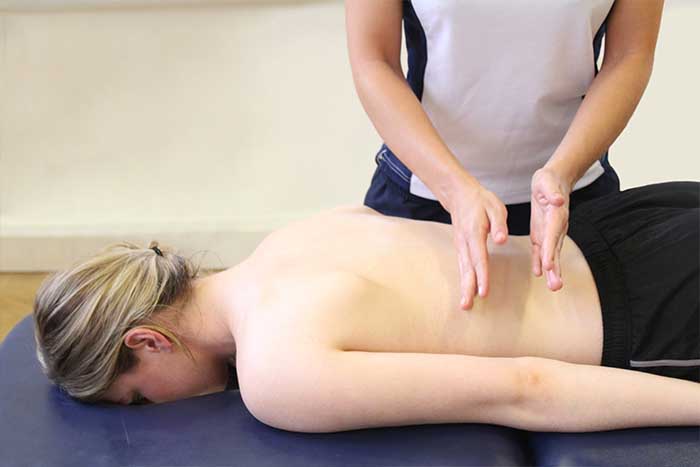
When can a lower back massage help?
There are many occasions in which a lower back massage can help. The occasions a lower back massage can help include:
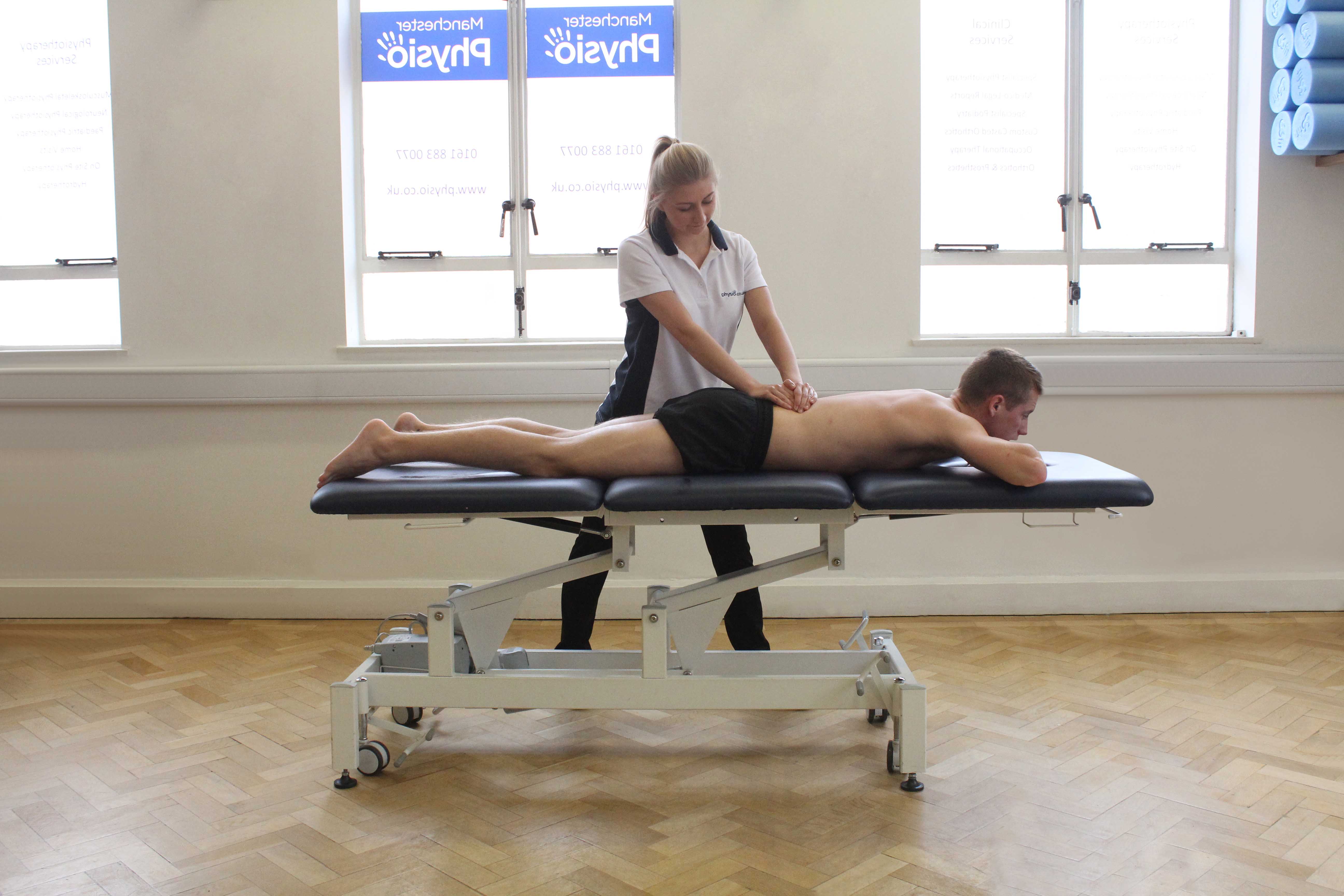 Above: Soft tissue massage of lower latissimus dorsi muscle
Above: Soft tissue massage of lower latissimus dorsi muscleHow does a lower back massage help acute pain?
Acute pain is helped through a lower back massage. Acute pain occurs when a signal is sent from the brain to the nerves in the body telling them to create pain.
A lower back massage aims to reduce pain by disturbing the signal sent to the brain, decreasing muscle tightness and improving tissue elasticity.
A lower back massage can disturb the signal sent to the brain from the receptors in the skin. The friction created between the fingers and skin during a lower back massage, sends a new signal to the brain. A new signal sent to the brain means that the nerves do not receive the message to cause pain. Disturbing the message therefore reduces pain.
Muscle tightness and tension is relieved as tissue elasticity is improved. As the temperature of the muscles is increased, tissue elasticity is improved. Tissue elasticity is improved as it becomes looser and able to stretch further without restriction. Improving tissue elasticity therefore reduces pain.
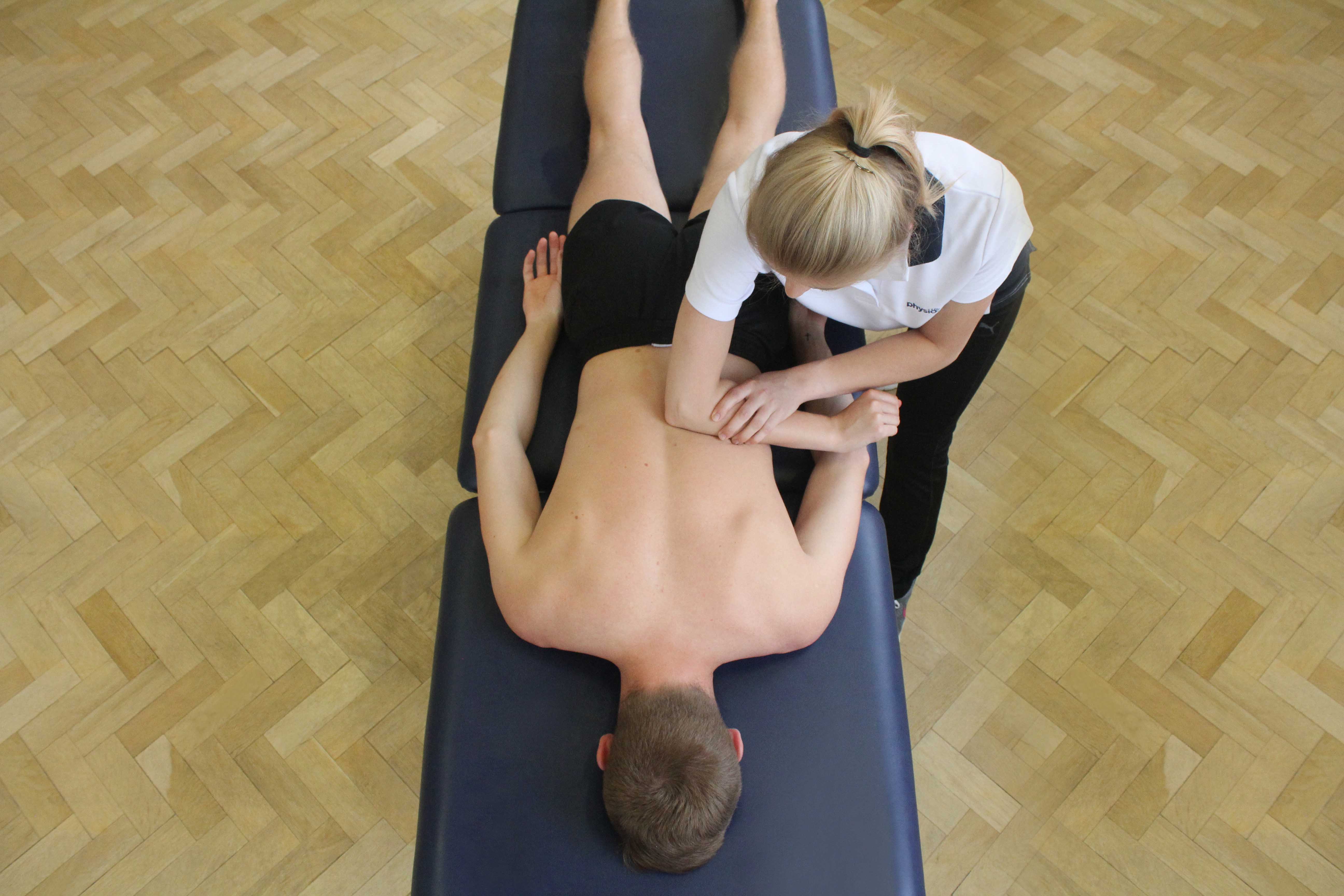 Above: Deep tissue massage applied to lower latissimus dorsi muscle
Above: Deep tissue massage applied to lower latissimus dorsi muscleHow does a lower back massage help post-surgery?
Surgery can leave damaging effects on the body. Muscles become restrictive and unable to move properly resulting in muscle tightness and tension. Muscle tightness and tension can create pain and discomfort.
A lower back massage aims to help the effects of surgery by relieving muscle tightness and stimulating the lymphatic system.
A lower back massage increases the temperature of the muscles. Temperature is increased as blood circulation improves. Increasing the temperature of the muscles improves tissue elasticity. When tissues become inelastic, they can cause restriction in movement and an increase in pain. Improving tissue elasticity reduces restriction and relieves muscle tightness to help reduce pain.
When muscles are restricted in movement, lymphatic circulation tends to become less efficient. A less efficient lymphatic system means that an increase in metabolic wastes are able to build up in the muscles, contributing to muscular fatigue and pain. A lower back massage can stimulate the lymphatic system. Stimulating the lymphatic system increases the rate of metabolic wastes being removed through lymph flow and out of the body at the glands. A more efficient lymphatic system can increase healing, decrease recovery time and decrease pain.
How does a lower back massage help stress?
Stress is relieved through lower back massage. The body can be both mentally and physically affected by stress. A common sign of stress in the body is muscle tension. Muscle tension can become painful if not treated.
A lower back massage aims to reduce stress by relieving muscle tightness and psychologically relieving stress.
A lower back massage helps loosen muscles and relieve tension. Muscle tightness and tension is relieved as the temperature of the muscles is increased. Muscle temperature is increased due to an increase in blood circulation. When muscle temperature increases, an improvement in tissue elasticity and flexibility occurs. Improving tissue elasticity and flexibility reduces restriction, relieving tension and tightness in the muscles. Reducing tension and tightness physically reduces stress.
A lower back massage also helps reduce stress psychologically. A lower back massage decreases the levels of a stress hormone called cortisol. Cortisol is a negative hormone that can increase levels of anxiety and depression as well as stress. During a lower back massage, cortisol is reduced allowing the body to mentally relax and become stress free.
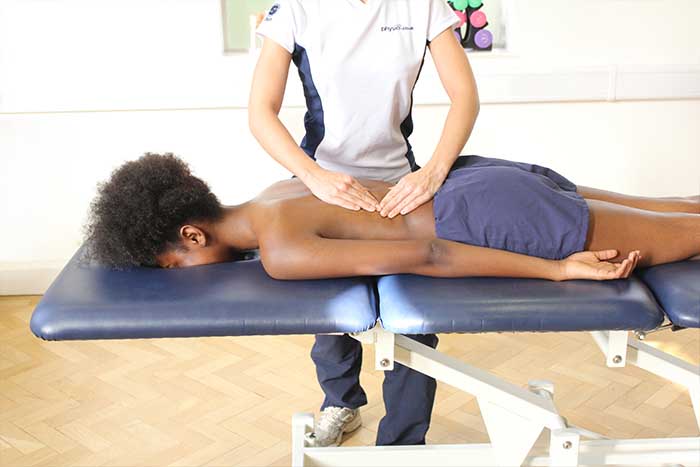
How does a lower back massage help tight muscles?
A lower back massage can help relieve tight muscles. Muscle tightness is most commonly caused by poor posture, overuse and injury. If not treated, muscle tightness can be restrictive and painful.
A lower back massage aims to reduce muscle tightness by improving tissue elasticity.
During a lower back massage, the skin and fingers create friction. When friction is created, an increase in blood circulation is encouraged. Increasing blood circulation, increases muscle temperature. When muscle temperature is increased, tissue elasticity and flexibility is improved. An improvement of tissue elasticity and flexibility decreases muscle tightness, reducing restriction and pain.
What are the benefits of a lower back massage?
There are various different benefits that can be gained through lower back massage. The benefits of a lower back massage include:
How does a lower back massage increase range of movement?
A lower back massage can increase range of movement. When muscles become tight due to overuse or injury, they can become painful restrictive.
A lower back massage aims to increase range of movement by relieving muscle tightness.
A lower back massage increases the temperature of muscles, improving tissue elasticity and flexibility around a joint. Improving tissue elasticity and joint flexibility relieves muscle tightness. Relieving muscle tightness reduces pain and restriction therefore increasing range of movement.
How does a lower back massage decrease pain?
Decreased pain is a benefit gained through a lower back massage. When muscles become tight or tense for reasons such as poor posture, overuse and injury, they can become painful.
A lower back massage aims to relieve pain by reducing muscle tension and disturbing pain messages sent to the brain.
Muscle tension is relieved as temperature of the muscles rise. Rising muscle temperature is due to an increase in blood flow caused by friction. Tissue elasticity is improved as muscle temperature rises. An improvement of tissue elasticity relieves muscle tightness and tension to help reduce pain.
Receptors located around the body first detect when something is wrong within the body and then send a signal to the brain. Pain is caused by nerves that receive a message from the brain telling them to create a feeling of pain. During a lower back massage, friction is created between the fingers and skin. When friction is created, receptors detect a new feeling. Once detected, the receptors send a new signal to the brain. The signal then gets passed on to the nerves which then create a numbing sensation. Creating a new sensation helps to relieve pain.
How does a lower back massage break down scar tissue?
A lower back massage helps break down scar tissue. Scar tissue is formed as a result of injury or surgery. Scar tissue can be restrictive resulting in muscle tightness and tension.
A lower back massage aims to loosen and break down scar tissue to relieve muscle tightness and tension.
As muscle temperature is increased, the temperature of the scar tissue also increases. Increasing the temperature of scar tissue allows them to be broken down more easily as they begin to loosen. As scar tissue is broken down, the collagen fibres making up the scar tissue are realigned, reducing restriction. Increasing temperature of scar tissue also improves its elasticity. Improving elasticity of the scar tissue further reduces restriction therefore relieving muscle tightness and tension.
How does a lower back massage maintain healthy muscles?
The maintenance of healthy muscles is a benefit gained from a lower back massage.
A lower back massage aims to maintain healthy muscles by improving blood circulation and stimulating the lymphatic system.
Blood circulation is improved as muscle temperature rises resulting in vasodilation. Vasodilation is where blood vessels below the skin widen allowing an increase of blood to travel through them. Improving the blood circulation increases oxygen and nutrients being delivered around the body. An increase in oxygen and nutrients enables the muscles to fatigue and become injured less easily therefore becoming stronger and healthier.
A lower back massage also stimulates the lymphatic system. The lymphatic system is made up of vessel called lymph vessels that run around the body. The lymphatic system aids in the removal of waste products and toxins out of the body. The removal of waste products and toxins reduces fatigue within the muscles and therefore keeps the muscles healthy.
Summary
A lower back massage mainly focuses on a range of muscles located around the lower area of the spine. Techniques such as acupressure, kneading, myofascial release, wringing and cupping are used to help treat a range of injuries and conditions. A lower back massage can help treat acute pain, post-surgery, stress and tight muscles. A lower back massage effectively relieves pain as well as increases range of movement, breaks down scar tissue and maintains healthy muscles. Our massage therapists at Physio.co.uk use lower back massage to effectively relieve pain, tension, stress and tightness of muscles.
How can I arrange a Lower back massage?
The easiest way to arrange a Lower back massage at Physio.co.uk is to email us at office@physio.co.uk or call us on 0800 033 7800.
Alternatively if you have any questions please feel free to contact us.
We offer a 7 day service and provide home and clinic appointments.

 0330 088 7800
0330 088 7800


































